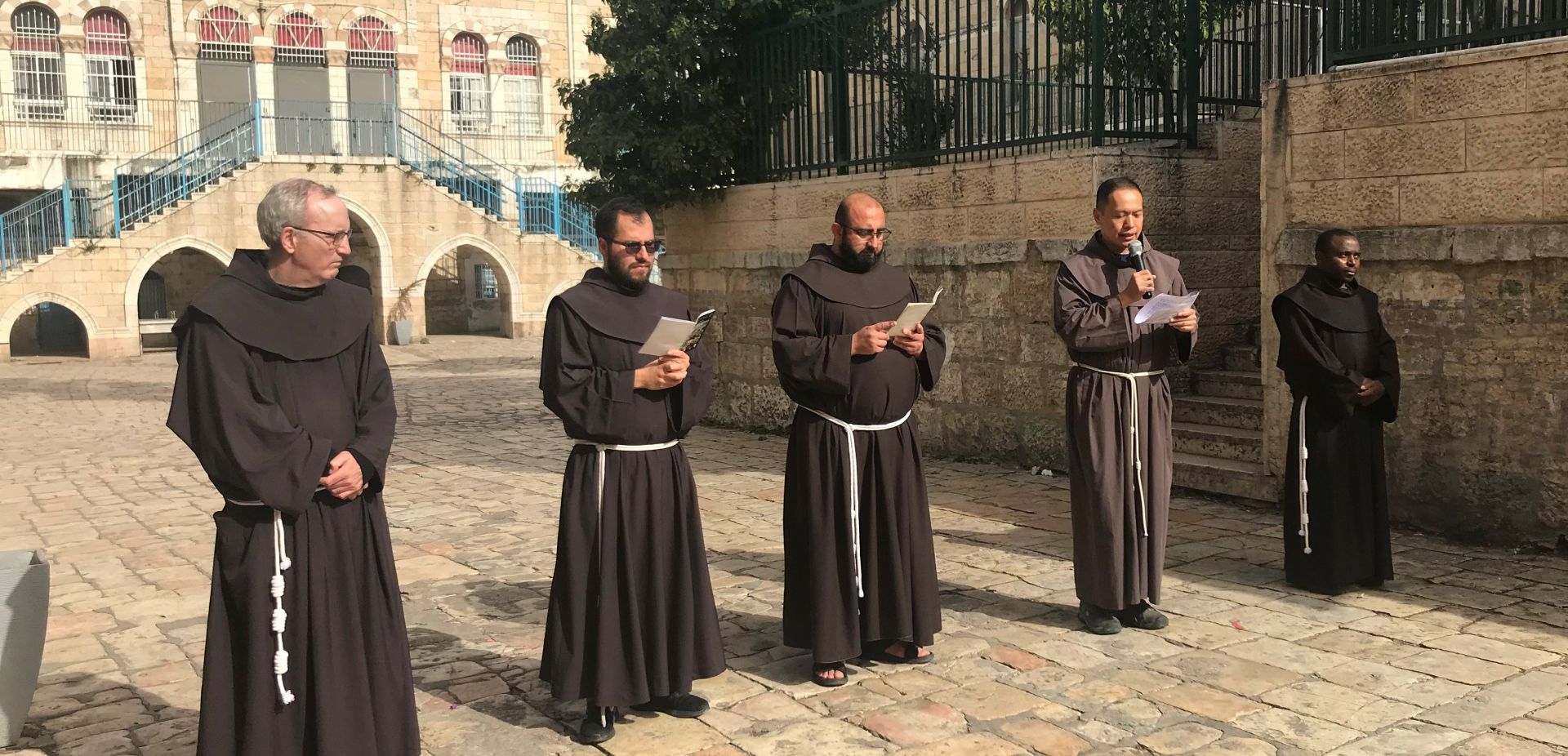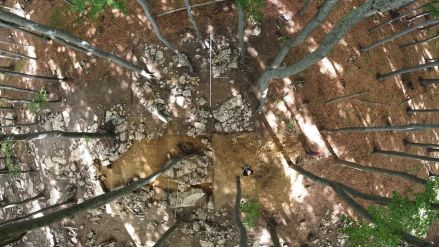 SIGN UP TO OUR PAGE
SIGN UP TO OUR PAGE

Nothing lost: every day at 4pm, a Franciscan procession marches through its interior recounting the Passion of Christ. This custom is mentioned in the diary of the pilgrim Egeria, who was in Jerusalem at the end of the 4th century. In 1431, the pilgrim Marian of Siena states that the Franciscans celebrate the procession independently of the other communities in the basilica. The individual stations were meditations on episodes of the Passion. Each consisted of an antiphon, verse and prayer, sometimes anthems. A version of the procession was approved by the Custodian of the Holy Land, Thomas Obicini, in the Ordo Processionalis of 1623 and remained in use until 1925, when changes were made to the hymns to bring them into line with the Roman Antiphonary.
One hundred years ago, the number of stations was determined - 14. They do not correspond to the usual ones, and are related to the places in the basilica: Altar of the Blessed Sacrament, Column of the Scourging, Prison of Christ, Altar of the Dividing of the Garments, Grotto of the Finding of the Holy Cross, Chapel of Saint Helena, Chapel of the Coronation and Insult, Place of the Crucifixion on Calvary, Place, where Christ died on the Cross, the altar of the Mother of Sorrows, the Stone of Anointing, the Glorious Tomb of Our Lord Jesus Christ, the place of the appearance of Jesus to Mary Magdalene and the chapel of the appearance of the Risen Jesus to His Mother. The prayers emphasise that everything happened in this place, at this column, on this mountain, in this grotto.
The Franciscans' procession through the basilica moves at the same fast pace as on the Via Dolorosa - apparently the Order has walking in its blood. Father Wlodzimierz, who has been living in Jerusalem for three years - he is currently hearing confessions in the sacristy, but we can talk here, as the confessional is the quietest - he jokes that you have to run in the procession, plus there are stairs and holes in the basilica floor on the way, so the candles go out in a hurry and people light them from their neighbours. Franciscans have their own ways. Father Włodzimierz has learned various techniques, although he admits that for two months of ministry he did not know what the procession was about. The texts in Latin are written in poetic language and you have to read in. It was only after time that he began to truly pray.
Today, the 20 Franciscan monks are followed by a second number of faithful who picked up candles and prayer books earlier in the sacristy, because not everyone knows Latin. A wonderful feeling, everyone gives way to us. The roaring basilica quiets down a little and belongs to us. Only the route is truncated, there is a perpetual renovation going on and we start from station four at the altar of the division of vestments. The prayer booklet is in Polish, but it is difficult to concentrate on keeping up with the Franciscan ritual. The pages show wax stains from the dripping candles of my predecessors; after the procession, I hand over my copy. The candle stays forever.
The street network
Imprimatur does not imply revealed truth, but perhaps the mystic Katharine Emmerich, who obtained a vision of the Passion, was right. From her words, much can be deduced about the location of the Way of the Cross. "Jesus was led into an alley only a few steps wide, running down alleys, and full of rubbish and uncleanness. New torments awaited Jesus here. The executioners now had to walk close to Him and, of course, they did not miss opportunities to tease Him. Taunts and insults poured from windows and openings in the walls, servants and slaves, busy around the houses, pelted Him with mud and kitchen waste, and some wicked men poured stinking dishwater on His head. Even the children, incited, gathered stones into the underparts of their dresses and, running out into the middle of the road, poured them at Jesus' feet, insulting and blaspheming at the same time." Perhaps this means the poor eastern part of the city, rather than the rich western part, Jerusalem's West End?
"Thus amidst the magnified torment Jesus walked shakily along a street, already wider at this point and rising slightly upwards. At the end, the street turned left again, widened and rose slightly upwards. (...) Continuing along this street, the procession reached a vaulted gate in the old inner city walls. In front of the gate there is a vacant square where three streets converge. (...) The procession now advanced along a long street, turning slightly to the left, crossed by many side streets. (…)
The path now led a little downhill, towards the gate, still quite a distance away. The gate itself is solidly built and is quite long; first passing under one arched vault, then over a small bridge and under a second vault to emerge outside the walls. The gate faces south-west. To the left of the gate the wall continues south for a few minutes' walk, turns to the west and then runs south again and encircles Mount Zion. To the right of the gate the wall runs northwards as far as the corner gate, and from there it turns east along the north side of the city. (...) Looking from the gate by which Jesus was led out, to the left to the south-west, you can see the Bethlehem gate; these two gates are from the gates of Jerusalem closest to each other. In front of the gate, in the middle of the gateway, at the point where the road to the mountain of Calvary turns, stood a pounded-in pillar with a tablet fixed on it, on which, in large, white, as if pasted letters, was written the death sentence on the Saviour."
(…)
"After a moment's rest, the procession continued along the tortuous, wild road between the city walls and Calvary in a northerly direction. The henchmen, heedless of anything, chased Jesus uphill, dragged him by the ropes, beat him and pushed him. At one point, the road turned back, taking the southern direction again. Here Jesus fell for the sixth time under the weight of the cross, but the executioners, with greater cruelty than before, forced him to rise by beating him and drove him relentlessly up the mountain to the place of execution, where Jesus, breathless, almost fell to the ground with the cross for the seventh time. And then it is all known.
– Jakub Kowalski from Jerusalem
- Translated by Tomasz Krzyżanowski
TVP WEEKLY. Editorial team and jornalists


 SIGN UP TO OUR PAGE
SIGN UP TO OUR PAGE
 Nothing lost: every day at 4pm, a Franciscan procession marches through its interior recounting the Passion of Christ. This custom is mentioned in the diary of the pilgrim Egeria, who was in Jerusalem at the end of the 4th century. In 1431, the pilgrim Marian of Siena states that the Franciscans celebrate the procession independently of the other communities in the basilica. The individual stations were meditations on episodes of the Passion. Each consisted of an antiphon, verse and prayer, sometimes anthems. A version of the procession was approved by the Custodian of the Holy Land, Thomas Obicini, in the Ordo Processionalis of 1623 and remained in use until 1925, when changes were made to the hymns to bring them into line with the Roman Antiphonary.
Nothing lost: every day at 4pm, a Franciscan procession marches through its interior recounting the Passion of Christ. This custom is mentioned in the diary of the pilgrim Egeria, who was in Jerusalem at the end of the 4th century. In 1431, the pilgrim Marian of Siena states that the Franciscans celebrate the procession independently of the other communities in the basilica. The individual stations were meditations on episodes of the Passion. Each consisted of an antiphon, verse and prayer, sometimes anthems. A version of the procession was approved by the Custodian of the Holy Land, Thomas Obicini, in the Ordo Processionalis of 1623 and remained in use until 1925, when changes were made to the hymns to bring them into line with the Roman Antiphonary. 



